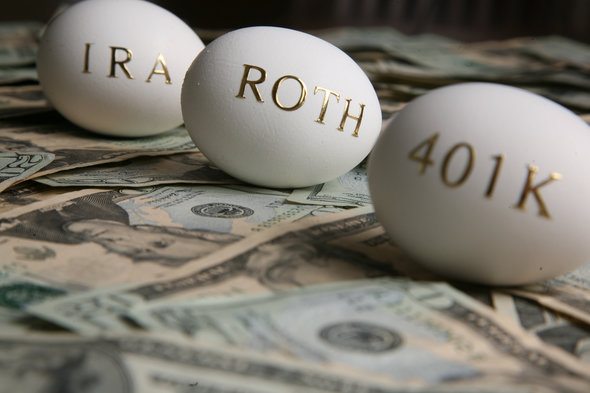
It can be hard to know if your retirement savings are on track, but comparing your balance to where others similar in age are can help. In particular, taking a look at the average 401(k) balance by age is a good place to start because an employer retirement account is an even playing field that gives most the best chance for retirement savings. Since an employer-sponsored 401(k) retirement account allows you to grow your assets tax-deferred, their long-term savings potential is quite high. While you should take full advantage of your 401(k), you’ll also need a retirement plan beyond it. If you’re unsure of where to start, try working with a financial advisor.
Saving for Retirement
There are many ways to save for retirement, from opening your own individual investment account to receiving matching contributions from an employer in their sponsored 401(k). Some people even put their retirement savings into a straight savings account or into a variety of real estate that is expected to increase in value over time.
If you have access to an employer-sponsored 401(k) then that might be the best way to save as much as you can for retirement. Plus, you can get free contributions from your employer if they offer to match. This can help you grow your retirement savings much faster than other methods like an IRA which has a much lower maximum contribution limit each year.
Many people worry that they don’t have enough money saved at a given age compared to what they are going to need come retirement time. A great way to know whether you’re on track is to work with a financial advisor who can help you understand how much you should be saving each month for your unique goals. If you need a rough estimate, looking at the average 401(k) balance by age can help you gauge how close you might be to where you should be for your current age.
Average 401(k) Balance by Age
The average American’s 401(k) balance as of 2023 varied significantly by age, according to data from Vanguard. The total average was $112,572. The older you get the more money you likely have saved or accumulated in your 401(k). We’ve provided the averages by age group below but it should be noted that you may need significantly more in your 401(k) at each age threshold, depending on what type of lifestyle you want when you retire.
Average 401(k) Balances for Americans by Age Group
- Under 25: $5,236
- 25-34: $30,017
- 35-44: $76,354
- 45-54: $142,069
- 55-64: $207,874
- 64 and above: $232,710
How Much Should I Contribute to My 401(k)?
There are a couple of rules of thumb to consider when determining exactly how much you should be stashing away. Whether or not your employer matches, how long you’ve been at your job and how much you’re making all factor into how much it’s possible for you to put aside.
Fidelity recommends that you should’ve saved roughly the same amount as your annual salary by the age of 30. However, some other experts say you should aim to have half of your annual salary saved by that age.
If you go by Fidelity’s benchmark and you earn $40,000 a year, aim to have about that amount socked away for retirement by age 30. By the time you’re 40, you should have tripled your annual salary. By age 50, you should have six times. When you turn 60, you should have eight times. And by age 67, you should have 10 times your annual salary in savings.
What If I Have a Below-Average 401(k) Balance for My Age?

If you’re 401(k) savings don’t quite match up with the figures we’ve mentioned, don’t panic. It’s never too late to start saving. While the ideal situation is obviously to have started saving early enough that compound interest can do the work for you, there are ways to get back on track.
The most obvious is to start tucking away as much as possible. As of 2023, the maximum amount you can contribute to your 401(k) on an annual basis is $22,500 ($23,000 in 2024). Participants aged 50 and older playing catch-up can contribute an additional $7,500 during the calendar year.
Though it may seem daunting to start saving at a notably higher rate, there are likely areas where you can cut back. One big thing to look at is whether you can downsize your living space. Also, make sure you don’t have any lingering debts weighing you down.
Another option is to push back your retirement age. This allows you to make up – at least somewhat – for the years you weren’t accruing compound interest. As a bonus, for each year you delay retirement, your Social Security benefits increase. Social Security benefits can’t take the place of retirement savings, but they can help you cover retirement expenses.
There’s also always the option of picking up some work in retirement – also known as a “worktirement.” It’s becoming more and more common for retirees to pick up some work post-retirement to supplement their savings. And if it’s any comfort, you’re not alone in being behind. In fact, more than half of Americans said in 2023 that they have fallen behind on retirement savings.
Alternatives to a 401(k)
A 401(k), a 403(b) and a 457(b) are employer-sponsored retirement plans. These options are particularly lucrative if the employer offers a match. All of the plans operate similarly, but a 403(b) is typically for public employees and a 457(b) is for some government employees.
But they’re not the only options for retirement savings. You might also consider an IRA: either the traditional IRA or the Roth IRA. Contributions to the traditional IRA, like the 401(k), are tax-deferred. That means you put the untaxed money in now and pay your taxes later. The Roth IRA, on the other hand, gets taxpaying out of the way up front. The money that goes into a Roth IRA has already been taxed, so when you get the money out you won’t pay any more.
However, to qualify for a full contribution to a Roth IRA you have to make a modified adjusted gross income (MAGI) of less than $138,000 for the 2023 calendar year ($146,000 in 2024). For couples filing jointly on their 2023 taxes, their AGI must be less than $218,000 ($230,000 in 2024). Once you have a MAGI of more than $153,000 and $228,000 respectively ($161,000 and $240,000 in 2024), you won’t be able to contribute at all.
The biggest differences between an IRA and a 401(k) are the contribution limits and how you contribute. Contribution limits to a 401(k) are generally much higher than to an IRA. While a 401(k) is offered by an employer, you can easily go online and open an IRA for yourself.
Your 401(k) contribution automatically comes out of your paycheck, but you’ll have to move the money yourself into an IRA. Notably, only a 401(k) comes with employer matches. You can always put money in both, too. A Roth IRA, for instance, might be a nice complement to your 401(k).
Bottom Line

Whichever option you choose, make sure you’re always managing your money with an eye toward retirement. It’s not impossible to catch up if you fall behind, but it’s far easier to accumulate your retirement savings steadily and slowly over time. To diversify the placement of your money, be sure to also take advantage of multiple retirement savings options. For example, these can include an individual retirement account, a savings account or an annuity.
Tips for Saving for Retirement
- Working on your retirement plans with a financial advisor can help you stay on track. Finding a financial advisor doesn’t have to be hard. SmartAsset’s free tool matches you with up to three vetted financial advisors who serve your area, and you can have a free introductory call with your advisor matches to decide which one you feel is right for you. If you’re ready to find an advisor who can help you achieve your financial goals, get started now.
- Take advantage of your company’s 401(k) match. This might seem like a no-brainer, but many Americans aren’t taking full advantage of their employer’s match. About one in four Americans miss out on an estimated $1,300 a year because they aren’t contributing enough to get the full employer match.
Photo credit: ©iStock.com/Ridofranz, ©iStock.com/pinkomelet, ©iStock.com/jygallery